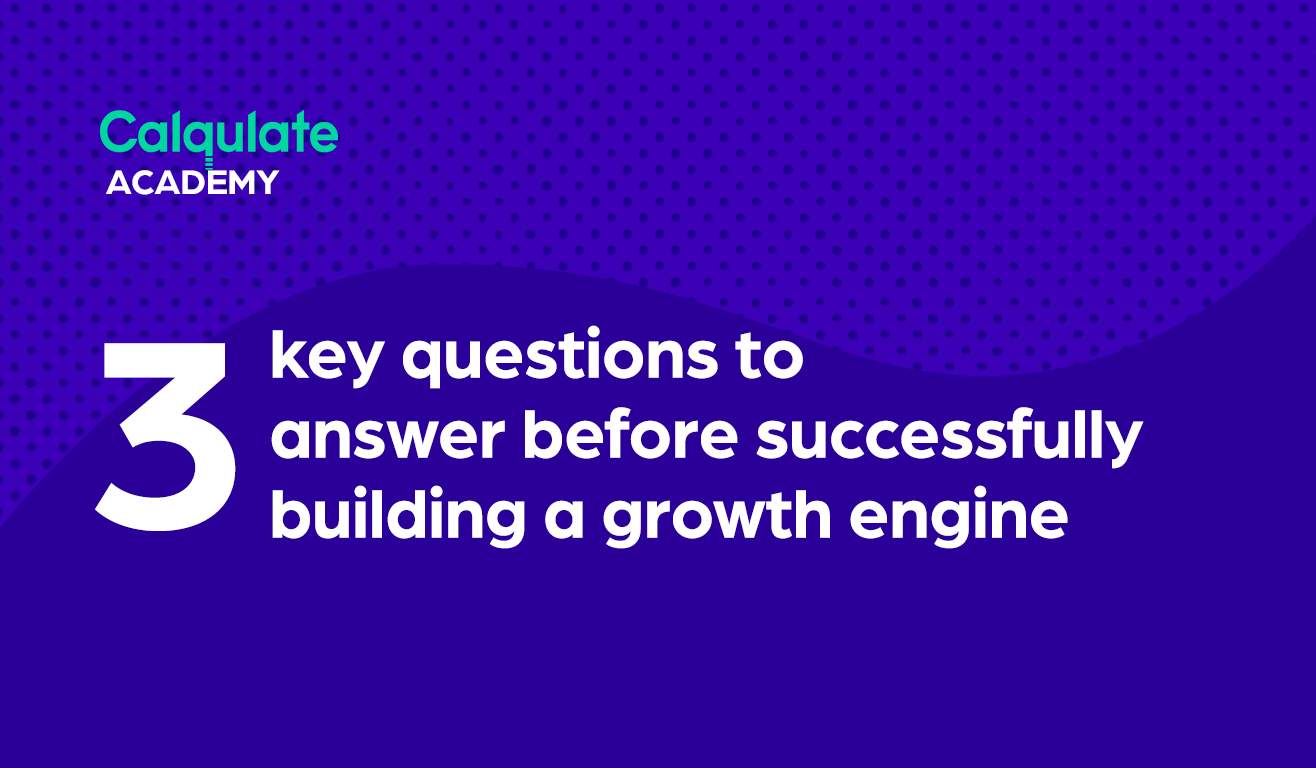There are two things I constantly repeat like a broken record:
- Never look at any metrics in isolation.
- Always (always!) make finance-led decisions.
As both the CEO and CFO of a SaaS company, it’s my responsibility to drive the strategic direction of Calqulate AND make sure we always have enough cash reserves to keep going.
In simpler terms, I watch our financial analytics like a hawk.
Everything we do or build is metric-driven, including our growth engine – it’s all about making the best use of your metrics and reacting quickly if anything is out of place.
The beauty of a growth engine is that it’s a self-sustaining, revenue-generating growth loop that drives your scalability. There’s no one-size-fits-all formula for it. But here’s how you can build one by using your financial analytics.
To build a growth engine, you need to answer three big questions:
1. Where do I want to go?
What’s the first thing you do when using your GPS or Google Map? You key in your destination before deciding which route or mode of transportation to take.
In this case, your destination means the output you want to achieve. Let’s say you’re now a $5 million Annual Recurring Revenue (ARR) startup, and your goal is to hit $10 million ARR in the next 12 months – that’s where you’re heading to.
Typically, the output metrics for a SaaS business are:
- Number of new subscriptions
- Number of upgrades (Net Revenue Retention)
- Average Revenue Per Account (ARPA)
- Churn
- Monthly Recurring Revenue (MRR)
- Billing cycle
- LTV to CAC analysis
- CAC payback time
Then comes the next question.
A quick Google search will reveal different models, different ways of building a growth engine, and even different ways of looking at it. But it all leads to one thing and one thing only, growth.
For example:
- Dan Martell’s growth engine is made up of three major components – marketing channels, product story, product marketing.
- Dan Hockenmaier and Lenny Rachitsky proposed that a growth engine is typically made up of performing marketing, virality, content, and sales.
- Eric Ries identified three growth engines for a SaaS startup – virality, customer retention, and customer acquisition through paid channels.
- You can also build a growth engine by switching your monthly offers to annual offers – it’s a great way to quadruple your MRR without raising additional funding. I’ll explain this one further later in this lesson.
As I’ve mentioned earlier, there isn’t a one-size-fits-all formula to build a growth engine. You have to find your own engine. What all the above examples have in common are the following components:
- Customer success
- Lead generation
- Customer conversion
3. Which element should I invest in to get there?
Let’s build on the above components:
- Customer success
If your customers are not successful in whatever they’re doing, your business won’t survive. Remember, friction is very costly. Nobody is going to stick around for a product that doesn’t work. Think about the last time you gave up on a product because it didn’t work the way you wanted it to. Your customers are no different.
They are also your biggest asset. My advice is to keep up communication with your customers and pay attention to what they’re telling you. Their feedback is important in helping you build a great product.
Metrics to measure this component: Lifetime value (LTV), churn, number of customers, trial to paid subscription conversion rate.
- Lead generation
If you already have a customer database, it means that there is a demand for your product. Run a customer segment analysis using your ARPA and LTV to identify your best customer segment.
Once you’ve identified your most valuable customer segment, you need to figure out how to attract more of these customers.
The great thing about customer segmentation analysis is that you no longer need to cast a wide net and hope to attract a few of those. It means that you will also be lowering your Customer Acquisition Costs (CAC).
After you’ve acquired them, you can focus on retaining them and increase your LTV.
Metrics to measure this component: CAC, LTV, ARPA
- Customer conversion
Your leads will not be of any value to you if you don’t convert them into customers. There are two stages of conversion – Leads to new customers, and existing customers to expansion. Expansion means your existing customers are upgrading their subscriptions thus increasing your MRR.
Metrics to measure this component: NRR, LTV to CAC ratio
Remember how I always say never look at your metrics in isolation? Your metrics are closely tied to each other, and their relations are even more apparent in your growth engine.
For example, former CMO at Teamwork, Drew Sanocki, discovered that he could increase his LTV by over 100% by decreasing his churn rate by 30%, increasing ARPA by 30%, and increasing total customers by only 30%.
Annual subscriptions as a growth engine
Ask any startup founder and they will tell you their number one worry involves cash (you probably know this already). It’s one of the most challenging factors in getting a startup running. The lack of it will hinder scalable growth.
However, there is a way to quadruple your MRR so that you can reinvest your cashflow into your customer acquisition and product development. The advantages of switching to annual offers are:
- Improved LTV to CAC ratio
- Lower customer acquisition costs payback time
- More stable revenue and cashflow forecasting
- Lower customer acquisition costs
- Lower churn rates
All of the above spells growth and profit.
The biggest impact of it all is on your CAC payback time – how long it takes to break even. Typically, it takes approximately 9-12 months for a SaaS business to breakeven. You should always aim to have a CAC payback time of less than 12 months to be profitable.
With annual offers, you will receive an upfront payment of 12 months at the beginning of the customer relationship. That means your CAC payback time is immediate (or negative) and you have more available cash to acquire new customers.
Being cashflow positive from Day 1 will allow you to focus on onboarding new customers at a faster rate. For example, instead of acquiring 180 new customers in 36 months on a monthly deal, you’ll have the resources to acquire 863 new customers for the same period.
Now, that’s something! That $10 mil ARR doesn’t seem that far away anymore, does it?
Go deeper: Quadruple your MRR without raising money after your seed round.
Conclusion
You may think you need to have a growth engine that’s complete before you start driving growth. That’s not true.
According to Ari Korhonen, an angel investor in Europe, your growth engine is never ready. You can and should optimize it constantly, make incremental changes and typically the most suitable engines evolve or even change when the company grows.
Once you’re able to understand your metrics better, you’ll be able to understand which part of your business is underperforming and identify opportunities for improvement.
That is easier said than done. But building a growth engine requires some experimenting before finding the right fit for your business – and it all starts with a great product and your financial analytics.
Happy Calqulating!

